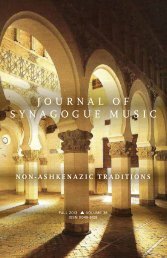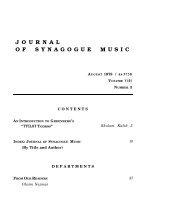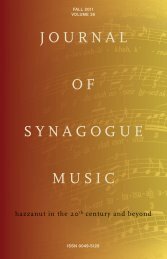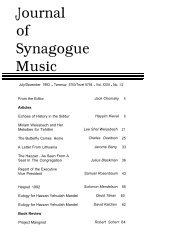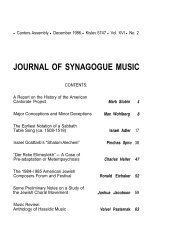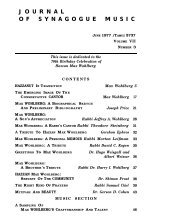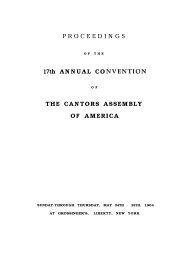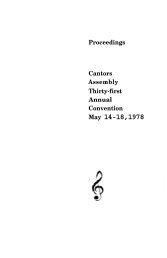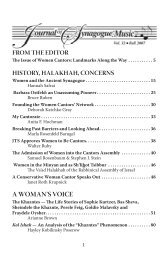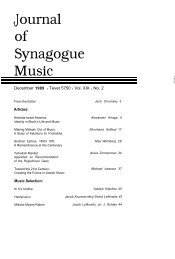ninth annual conference-convention - Cantors Assembly
ninth annual conference-convention - Cantors Assembly
ninth annual conference-convention - Cantors Assembly
You also want an ePaper? Increase the reach of your titles
YUMPU automatically turns print PDFs into web optimized ePapers that Google loves.
oth fields, and choral arrangements of folk, Hebrew,<br />
Yiddish, and chassidic songs. There is also a voluminous<br />
amount of compositions in manuscript, privately<br />
owned and just acquired by the <strong>Cantors</strong> <strong>Assembly</strong>.<br />
This is a mark of achievement which, you will agree,<br />
many other Jewish composers will be proud to equal.<br />
Throughout his secular songs, regardless of type<br />
or style, runs the bright line of melody, -lyrical,<br />
sprightly, or stately, as the selection demands. Occasionally<br />
there may be revealed a trace of a particular<br />
foreign influence (perhaps Russian, or German). But<br />
these traces are too few and infrequent to be other<br />
than of unconscious usage.<br />
In the liturgical field we encounter melodies built<br />
on the synagogal, cantillation modes. Although these<br />
modes are basic to the compositions of an appreciative<br />
number of writers who have contributed to the<br />
treasure chest of liturgical music, I doubt that any<br />
one of these writers can measure up to the creative<br />
genius of Zavel Zilberts in his straightforward approach<br />
to the music of the synagogue. His standards<br />
were high and he refused compromise.<br />
He was, to give him a name, a modernist of the<br />
traditional school, in both liturgical and secular writings.<br />
The basic material, the established Nushuot, is<br />
inherent in the Cantus Firmus of his creations, with<br />
very few exceptions. But in the development of the<br />
thematic body of his compositions, one always finds<br />
invention and innovation, not merely embellishment.<br />
And the compositions, as total works, have cohesion<br />
and unity of spirit with the subject matter.<br />
Zilberts did not fall into the trap which has ensnared<br />
so many of his and our contemporaries. That<br />
is, his compositions had an integrity and profound<br />
character for which they were intended. Invention,<br />
or design, or effect, for the sake of invention, or design,<br />
or effect, was not part of his make-up. Only so<br />
far as he could add to the complete musical picture<br />
did he use his talent for artistic invention.<br />
His early impressions had an unmistakable effect<br />
on his music, from the standpoint of scope. His affinity<br />
for grandeur was quite evident in his major<br />
works. His talent was for seeing a creation in terms<br />
of compass and fullness. And to that end, his works<br />
were fashioned with a sweep and a breadth that are<br />
inspiring and uplifting.<br />
Notwithstanding the proportions of Zilberts’ creations,<br />
there was no detail that escaped him. He was<br />
painstaking to an extreme degree. The most minute<br />
and detailed observations and directions were recorded<br />
as he attempted to control the performances of his<br />
works. Only in some published works was he rather<br />
excessive in his use of symbols, phrases of dynamics<br />
and interpretation.<br />
Versatility of style can be readily seen in Zilberts’<br />
treatment of four poems by Bialik. The “Achas<br />
Shtayim” is written in liturgical style. “Hachnisini”<br />
is set as an art song, slow and thoughtful. “Minhag<br />
- 28 -<br />
Chodosh”, also in the art form, is sprightly and joyous.<br />
And the fourth song, “Unter Di Grininke Boimelach”,<br />
is written in folk style, simple and enchanting.<br />
He could be soul-stirring, as in his “V'Shomru”, and<br />
majestic as in his study of “Ma Godlu” (Metro). In<br />
this latter, the full majesty is proclaimed in a glorious<br />
manner.* The proclamation is created in the<br />
major mode but the full development and climax comes<br />
only after tension and excitement are built up by<br />
suspenseful interruptions in the minor mode. Only<br />
a master can create such a splendid recitative. In<br />
the “Tzadik Katomor Yifroch” part of this psalm, he<br />
opens in an arioso-like form and then skilfully incorporates<br />
part of the opening theme of the composition.<br />
His craftsmanship is evident as he weaves the parts<br />
together into a completed fabric.<br />
Can anyone add to musical history’s verdict in reference<br />
to the famous Zilberts “Havdoloh” (Metro)<br />
As original as this work is, it is steeped in the traditional<br />
Havdoloh Nusach. (I can never forget the<br />
first time I heard it. It brought to mind, like a distant<br />
echo, a picture of my late father chanting the<br />
“Hine El Yeshuosi” in the traditional nusach.) This<br />
magnificent composition, whose lengthy opening theme<br />
is a definite extraction from the Havdoloh-was created<br />
for the combination of cantor, choir, and piano<br />
or organ. Were it written instrumentally, it would be<br />
a fine symphonic poem.<br />
His “V'Shomru”, Op. 32, No. 2, (Metro) is another<br />
musical gem of the liturgy. It is saturated with the<br />
genuine Sabbath Eve Nusach.* There is an unending<br />
colorful combination if plaintiveness, and religious<br />
fervor that grips the listener until the closing note.<br />
Another of Zilberts’ most celebrated major compositions<br />
is his biblical cantata “Jacob’s Dream” (Metro),<br />
based on Abraham Reisen’s Yiddish poem, with<br />
additional English text by David M. Hausdorff. Practically<br />
every soloist of note has performed this impressive<br />
work, the solo part of which is usually rich<br />
in passages that display the voice.<br />
The solemn opening bars by the chorus in unison<br />
immediately set the mood and introduce the theme.<br />
As the cantata develops, the choral passages recede<br />
into the background as the soloist has the spotlight.<br />
The moving lines of melody converge in a path leading<br />
to a glorious climax. Then, in contrast to <strong>convention</strong>,<br />
a continuous diminuendo shading to a pianissimo<br />
finally reaches the ending, beautiful in its tranquility.<br />
Although devoted to traditional music modes<br />
of synagogal nature, he was twice invited, and commissioned<br />
to write for the Reform services. First<br />
was the Friday Evening service for the Reform Synagogue,<br />
“Neginoth Israel” (Bloch). This was written<br />
in the supposedly Reform style (a style which sometimes<br />
is described as non-Jewish music). Then again<br />
"Music for the Synagogue”, containing musical set-<br />
*Vocal Illustration.



